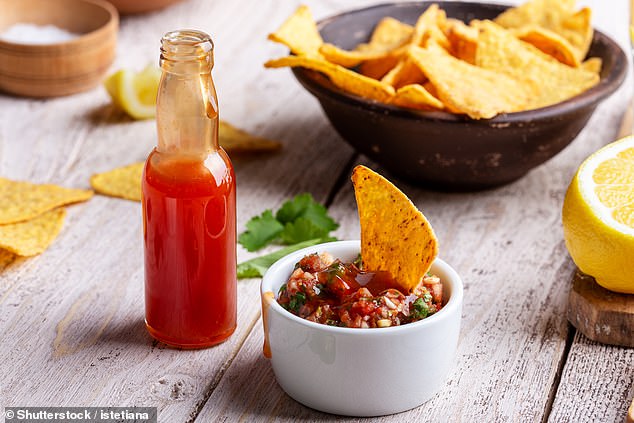Ditch popular snack duos that can make you eat nearly twice as many ‘mindless’ calories, scientists warn
If you serve the classic snack combo of chips and dip, you can consume almost twice as many calories as if you ate chips alone.
Researchers from Pennsylvania State University in the US found that people ate 77 percent more calories when they served a salty snack with a dip.
Study author John Hayes, professor of nutritional sciences and director of the Penn State Sensory Evaluation Center, expected that participants who added an extra element to a snack would compensate by eating less of the main ingredient.
But that was not the case.
Instead, serving salty snacks like chips with dip made no difference in how many chips participants were willing to eat: they just ate the dip with it.
The participants also ate faster and took larger bites than when they were given only chips.
Researchers from Pennsylvania State University in the US found that people ate 77 percent more calories when they were served a salty snack alongside a dip

Participants also ate faster and took larger bites than when given only chips.
In the studypublished in the journal Food Quality and Preference, 46 adult participants visited the lab twice over a two-week period to eat the snacks.
During one visit, participants were given 70 grams of ranch-flavored chips (about three small bags).
On another visit, they were given the same amount of chips with a third of a cup (3 ounces) of ranch dip.
They were allowed to eat as much as they wanted, and researchers recorded and monitored the number of bites they took and how long they ate.
The scientists were then able to calculate how quickly they ate and how large the bites they took were.
On average, participants consumed 345 calories in the form of chips and dip per meal, compared to just 195 calories when they ate the chips themselves.
‘The most striking finding from our research is that people did not eat fewer chips when dip was available – they ate the same amount of chips plus the dip,’ said Professor Hayes.
‘This lack of compensation means that adding dip can significantly increase total energy intake without people realizing it.’
He added: ‘Our participants ate the same amount of chips whether or not there was dip. When dip was available, they consumed much more energy.’
The study, led by research assistant Madeline Harper, found that the dip encouraged people to eat more of the salty snack.
Ms Harper suspects the higher calorie intake may be because people took bigger bites of the dip, rather than eating more quickly.
Professor Hayes added that understanding snacking behaviour is crucial to addressing problems with overeating and obesity.
“This research opens up new opportunities to investigate how the physical properties of foods can influence our eating behavior and ultimately our energy intake,” he said.
“If we can slow people down, we can influence energy expenditure without giving up the pleasure of eating.”
According to NHS guidelines, the average woman should eat around 2,000 calories a day to maintain a healthy weight, while for men this figure is 2,500.
Weight gain occurs when a person takes in more calories than they burn over time.
Obesity is known to increase the risk of serious health problems that can damage the heart, such as high blood pressure and cancer.
Experts blame the country’s ever-expanding waistlines on the simultaneous rise in processed foods and modern, sedentary desk-based lifestyles.
Two-thirds of all adults are now overweight, compared with just half in the mid-1990s. Of those, about a quarter are obese.
In terms of obesity, this equates to 16.8 million people, of which an estimated 8 million are women, 7.4 million are men, 760,000 are boys and 590,000 are girls.
According to government statistics, in the UK alone, 26 percent of adults are obese and a further 38 percent are overweight.
